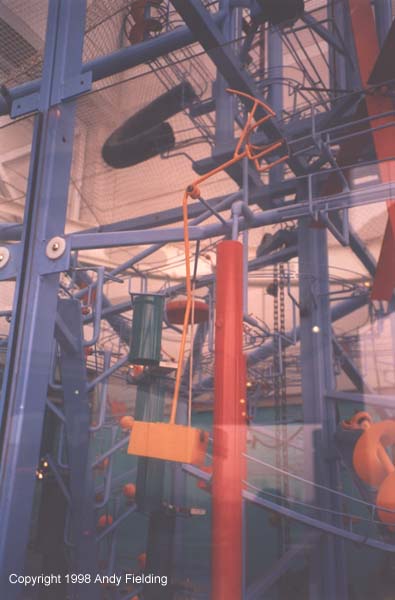The Rolling Ball Web
An Online Compendium of
Rolling Ball Sculptures, Clocks, Etc.
By David M. MacMillan et. al.
Andy Fielding took the following photographs of George Rhoads' Tower of Bauble (sometimes referred to as the Tower of Babel) and has graciously allowed their inclusion here.
Note: In scanning these photos with my particular scanner, I found it necessary to increase the brightness significantly to capture sufficient detail. As a result, these scans appear overexposed. The original photos are not.
Note: Some web browsers do not display images with full fidelity. For best image quality, save these images to temporary files and view them with an offline image viewing program. Please note that even when saved to files the licensing terms and the disclaimers stated in the Legal Matters section of this document still apply to these images.
(8 photos, approximately 210.9 kilobytes total)








Andy describes this sculpture:
Approaching the entrance, you first hear a wonderful cacophony of clanks, clinks, dings, whooshes, and bops. Then the sculpture looms into view. A 10-by-10-foot Plexiglas enclosure holds the lower half, while the "tower" (about another 15 feet) protrudes from its center.
Below is the legend posted on each Plexiglas wall (with my remarks in brackets).
THE TOWER OF BAUBLE
This giant kinetic sculpture was created by New York artist George Rhoads. The Tower of Bauble was originally built in 1985 for the North Hills Shopping Centre in Kamloops [B.C., Canada]. It was generously donated to Science World in 1995 by Robert E. Lee, Jack Poole, Robert J. MacDonald and Peter Comes.
The artist worked in conjunction with fabricators to build The Tower of Bauble. Rhoads describes his work as audio-kinetic sculptures that generate sounds as they move. Look and listen! -- for the trampoline, loop the loop, wok, wooden drums, helixes, cymbals, xylophone, spirals, firebell, and gongs.
Stay awhile and watch the progress of the bowling ball [actually a 4" lawn-bowling or "bocci" ball]. Rhoads' sculptures can also be found in the Boston Museum of Science, as well as the Airport [I assume they mean Boston], the Port Authority Bus Terminal in New York City, and the West Edmonton [Alberta, Canada] Mall. Some are more complicated than others, but they all share certain features.
TO DO:
Look for the ball distributor that feeds the initial supply of balls onto
several tracks.
What's Happening?
The Tower of Bauble is actually divided into two sections (top and
bottom), each with its own balls and paths. With a number of different
paths from top to bottom and several balls moving at once, the sculpture is
always changing. When the balls reach the bottom, a motorized chain hoist
carries them back to the top. This is the only point in which external
power is used; all the other action relies on gravity.
With the exception of any material noted as being in the public domain, the photos of this document are copyright © 1998 by Andy Fielding and the text and encoding are copyright © 1998 by David M. MacMillan.
This document is licensed for private, noncommercial, nonprofit viewing by individuals on the World Wide Web. Any other use or copying, including but not limited to republication in printed or electronic media, modification or the creation of derivative works, and any use for profit, is prohibited.
This writing is distributed in the hope that it will be useful, but "as-is," without any warranty of any kind, expressed or implied; without even the implied warranty of merchantability or fitness for a particular purpose.
In no event will the author(s) or editor(s) of this document be liable to you or to any other party for damages, including any general, special, incidental or consequential damages arising out of your use of or inability to use this document or the information contained in it, even if you have been advised of the possibility of such damages.
In no event will the author(s) or editor(s) of this document be liable to you or to any other party for any injury, death, disfigurement, or other personal damage arising out of your use of or inability to use this document or the information contained in it, even if you have been advised of the possibility of such injury, death, disfigurement, or other personal damage.
All trademarks or registered trademarks used in this document are the properties of their respective owners and (with the possible exception of any marks owned by the author(s) or editor(s) of this document) are used here for purposes of identification only. A trademark catalog page lists the marks known to be used on these web pages. Please e-mail dmm@lemur.com if you believe that the recognition of a trademark has been overlooked.
Version 1.6, 1998/06/24. Feedback to dmm@lemur.com
Go to the: